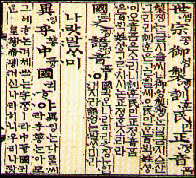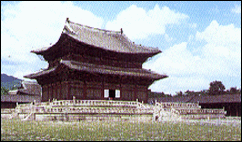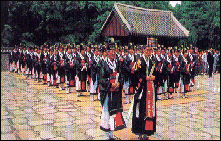KOREA>HISTORY>Choson
![]()
6. Choson
 The early
rulers of Choson replaced Buddhism with Confucianism in order to counter the
dominant Buddhist influence and to appropriate the great wealth accumulated
by monasteries during the Koryo period. Neo-Confucian theories of state and
society provided the ideological basis for wide-reaching reforms in the
hands of the elite of the new dynasty. Confucian ethics and values came to
dominate social structure and behavior through the following centuries. The early
rulers of Choson replaced Buddhism with Confucianism in order to counter the
dominant Buddhist influence and to appropriate the great wealth accumulated
by monasteries during the Koryo period. Neo-Confucian theories of state and
society provided the ideological basis for wide-reaching reforms in the
hands of the elite of the new dynasty. Confucian ethics and values came to
dominate social structure and behavior through the following centuries. The Choson rulers governed with a well-balanced, sophisticated political system. The civil service examination system was firmly established as the main avenue of recruitment for government office. The examinations formed the backbone of social mobility and intellectual activity during the period. The society in general highly valued academic learning while disdaining commerce and manufacturing. The Choson Dynasty had an auspicious beginning. During the reign of the fourth monarch, King Sejong (1418-50), enormous strides were made in the arts, science, and technology. Under his patronage, scholars at the royal academy invented the Korean alphabet, Hangul, a highly scientific yet simple and effective system of writing. Sejong's rule marked a "golden age" in Korean history. It produced numerous inventions and progressive ideas in the areas of government administration, economy, natural sciences, the humanities, music and medicine. In the late 16th century, however, Choson experienced the trauma of a seven-year war with Japan. After the court of Choson rejected a request by the Japanese warlord Toyotomi Hideyoshi to make way for his invasion of China, Toyotomi launched a Korean campaign. Most of the peninsula was devastated, and numerous Korean artisans and technicians including pottery artisans, were forcibly taken to Japan. At sea, Admiral Yi Sun-shin (1545-1598) conducted a series of brilliant naval maneuvers, employing the famous kobukson (turtle ships) against the numerically superior Japanese forces. On land, voluntary peasant fighters and contingents of Buddhist monks gallantly engaged the enemy. The Japanese began to withdraw with the death of Toyotomi and the war ended in 1598, having left a disastrous impact upon both Choson and Ming China. The Japanese attacks in 1592 and 1597 and Manchuria assaults in 1627 and 1636 ravaged the country's economy and turned much of the farmland to waste for a long period thereafter. From the early 17th century, a movement advocating practical studies gained considerable momentum among liberal-minded scholars as a way to build a modern nation state. They strongly recommended agricultural and industrial improvements, and sweeping reforms in land distribution. The government of conservative aristocrats, however, was not ready to accommodate their ideas.  In
the later half of the Choson Dynasty, the government administration and the
upper classes came to be marked by recurring factionalism. King Yongjo
(1724-1776) thus adopted a policy of impartiality to combat this and
succeeded in strengthening the royal authority and securing political
stability. He also instituted the Equalized Tax Law to ease the tax burden
on the general populace and to address the compulsory military service
problem, and initiated public works projects as well. His successor, King
Chongjo (1776-1800) maintained the policy of impartiality, established a
Royal Library to store royal writings and records, and initiated other
political and cultural reforms. In
the later half of the Choson Dynasty, the government administration and the
upper classes came to be marked by recurring factionalism. King Yongjo
(1724-1776) thus adopted a policy of impartiality to combat this and
succeeded in strengthening the royal authority and securing political
stability. He also instituted the Equalized Tax Law to ease the tax burden
on the general populace and to address the compulsory military service
problem, and initiated public works projects as well. His successor, King
Chongjo (1776-1800) maintained the policy of impartiality, established a
Royal Library to store royal writings and records, and initiated other
political and cultural reforms. This period also witnessed the rise of Sirhak or the school of practical learning among liberal-minded scholars. A number of outstanding scholars wrote progressive writings recommending agricultural and industrial improvements, and sweeping reforms in land distribution. Unfortunately, most of their ideas were ignored, and the government stuck to its orthodox ways. Korea remained a "hermit kingdom" adamantly opposed to the Western demands for diplomatic and trade relations in the 19th century. Korea adhered to its alliance with China, which was fighting for its own life against Western encroachment and could not help Korea. The Japanese were the first foreign power in recent history to succeed in penetrating Korea's isolation in 1875. After that, Korea signed treaties with the United States, Britain, Italy, Russia, and other countries were signed within the decade after the one with Japan. Internally, the Korean court split into rival pro-Chinese, pro-Japanese, and pro-Russian factions, the latter two having more reformist and modernizing orientations. In 1895 the Japanese minister to Korea masterminded the assassination of the Korean queen, who with her clan had opposed reform-oriented, Japanese-supported leaders. The Korean king, however, rejected not only Japan but also the various reform measures and turned for support to one of Japan's adversaries--Russia. The king fled to the Russian legation in Seoul to avoid possible Japanese plots against him and conducted the nation's business from there. The Japanese blunder had served the Russians well.  The revolt of 1894-95, known as the
Tonghak Rebellion, had international repercussions. The Tonghak participants
were fired by religious fervor as well as by indignation about the corrupt
and oppressive government. The rebellion spread from the southwest to the
central region of the peninsula, menacing Seoul. The Korean court apparently
felt unable to cope with the rebels and invited China to send troops to
quell the rebellion. This move gave Japan a pretext to dispatch troops to
Korea. The two countries soon engaged in the First Sino-Japanese War
(1894-95), which accelerated the demise of the Qing Dynasty in China. The revolt of 1894-95, known as the
Tonghak Rebellion, had international repercussions. The Tonghak participants
were fired by religious fervor as well as by indignation about the corrupt
and oppressive government. The rebellion spread from the southwest to the
central region of the peninsula, menacing Seoul. The Korean court apparently
felt unable to cope with the rebels and invited China to send troops to
quell the rebellion. This move gave Japan a pretext to dispatch troops to
Korea. The two countries soon engaged in the First Sino-Japanese War
(1894-95), which accelerated the demise of the Qing Dynasty in China. Russian influence had been on the rise in East Asia, in direct conflict with the Japanese desire for expansion. The strategic rivalry between Russia and Japan exploded in the Russo-Japanese War of 1904-5, won by Japan. After that, Korea was obliged to become a Japanese protectorate, and Japan annexed Korea as a colony in 1910. |
